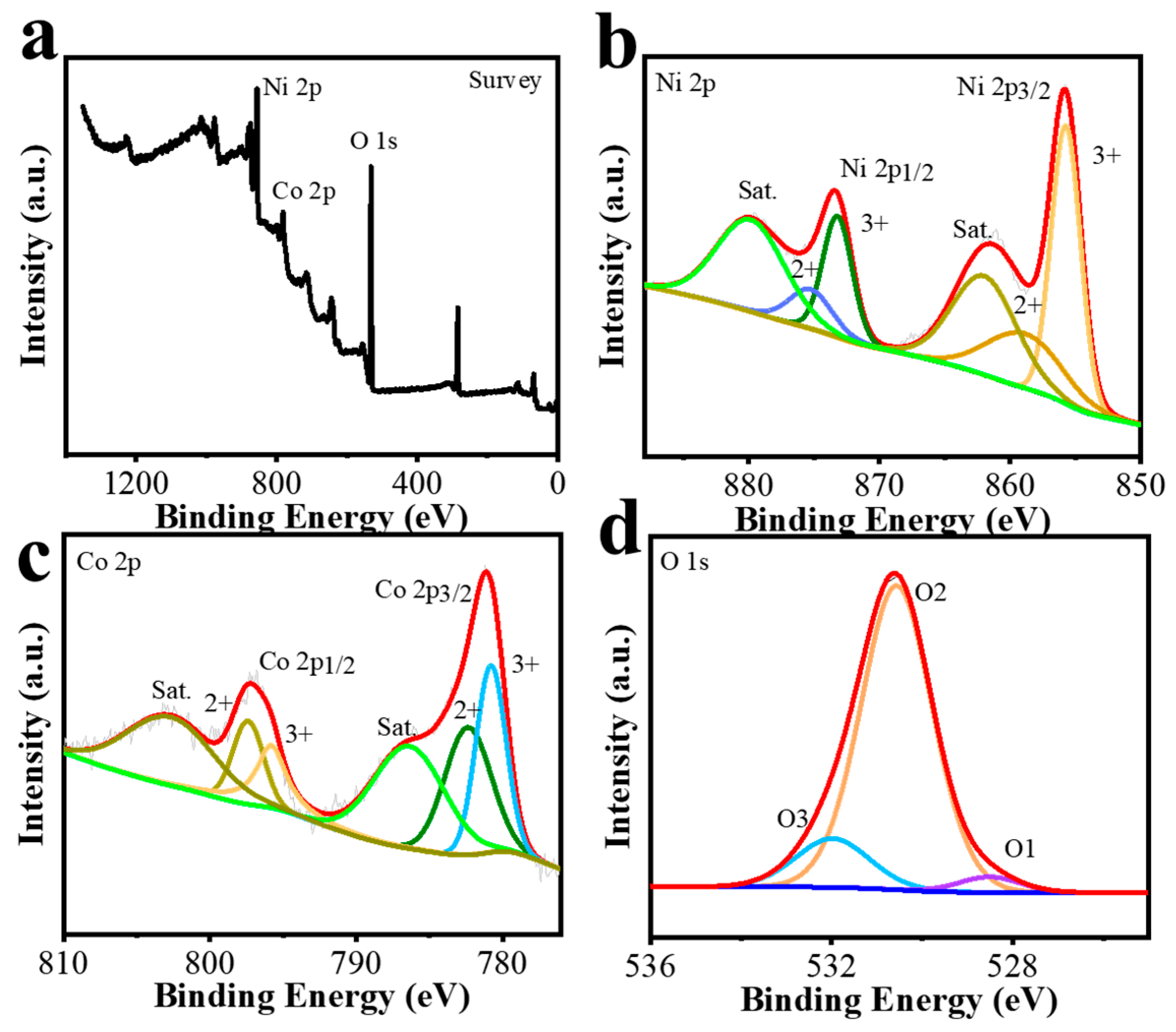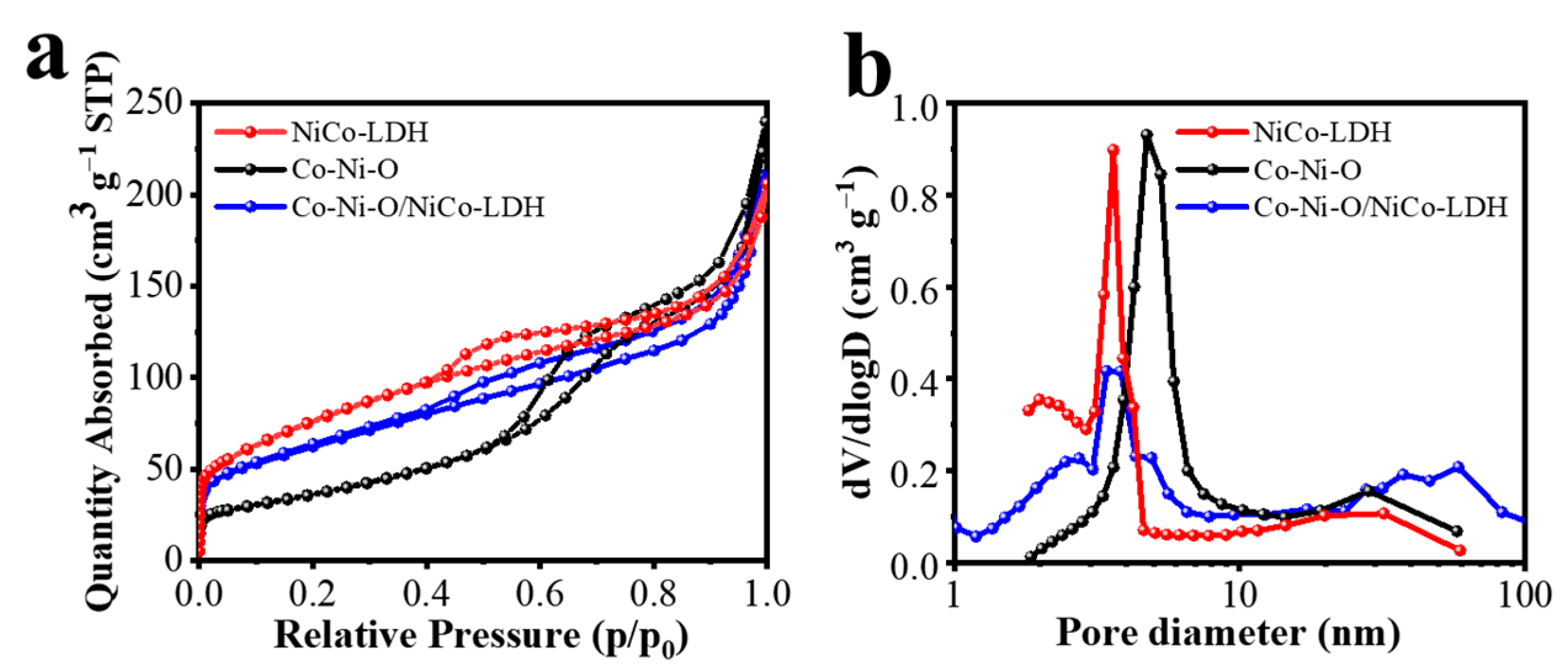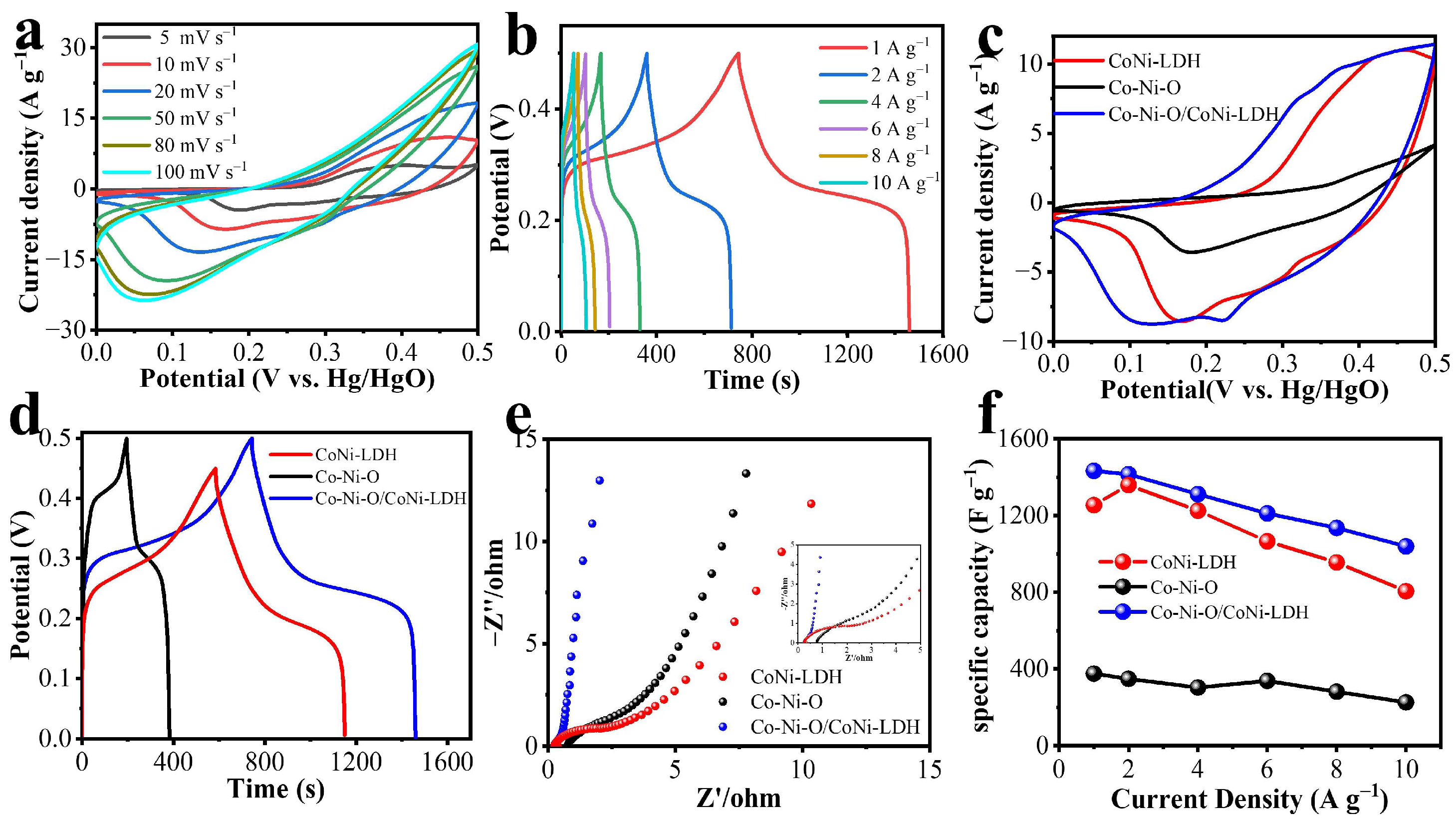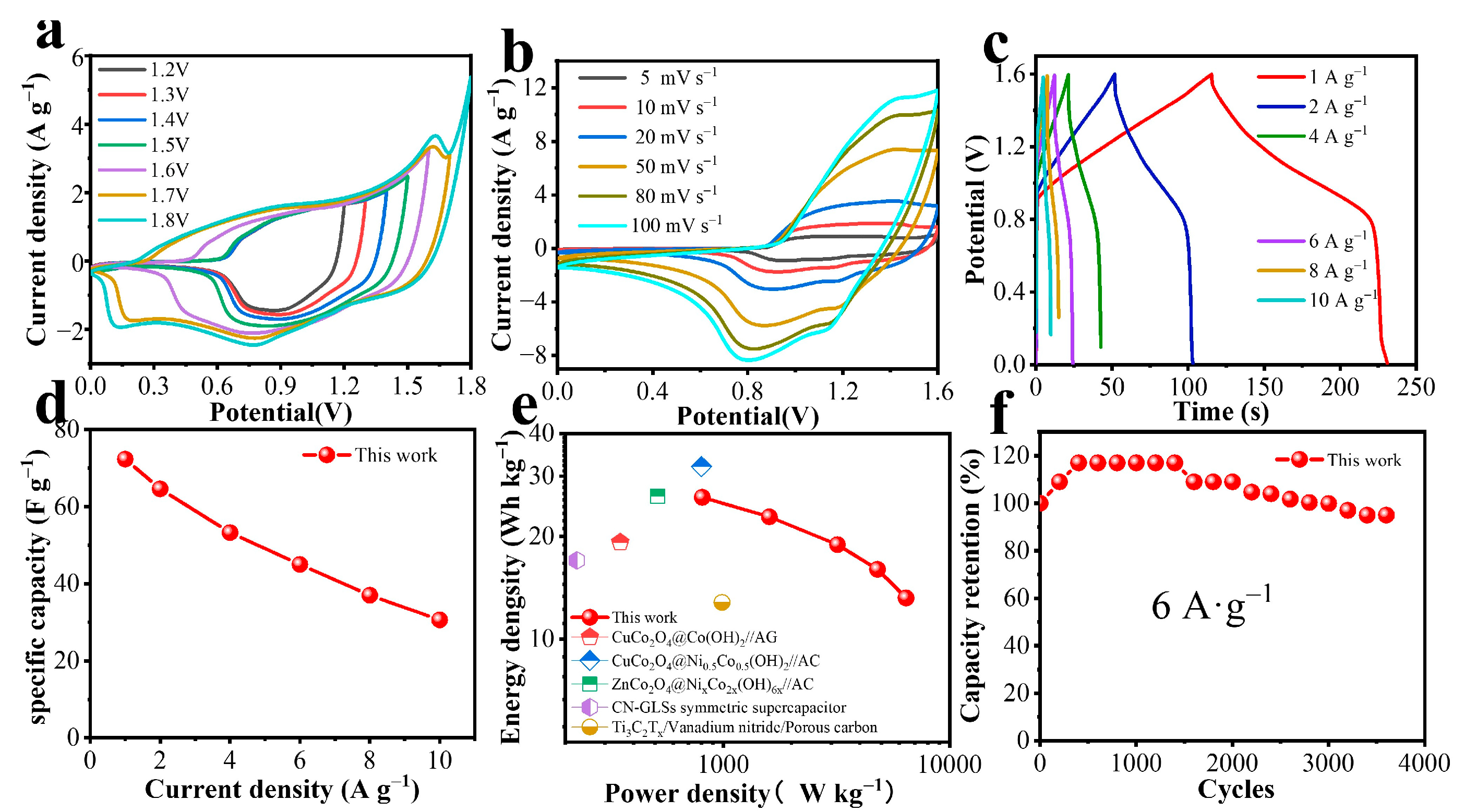Structure-Engineered Core–Shell Ni–Co–O/NiCo-LDH Nanospheres as High-Performance Supercapacitor Electrodes
Abstract
:1. Introduction
2. Experimental Sections
2.1. Sample Preparations
2.1.1. Preparation of the Chinese Chestnut-like NiCo-LDH and Ni–Co–O
2.1.2. Preparation of the Ni–Co–O/NiCo-LDH Core–Shell Composite
2.2. Characterization
2.3. Electrochemical Measurements
3. Discussion and Results
Characterization
4. Conclusions
Supplementary Materials
Author Contributions
Funding
Institutional Review Board Statement
Informed Consent Statement
Data Availability Statement
Acknowledgments
Conflicts of Interest
References
- Ben Gouider Trabelsi, A.M.; Elsayed, A.H.; Alkallas, F.; Al-Noaimi, M.; Kusmartsev, F.V.; Rabia, M. A Fractal, Flower Petal-like CuS-CuO/G-C3N4 Nanocomposite for High Efficiency Supercapacitors. Coatings 2022, 12, 1834. [Google Scholar] [CrossRef]
- Liang, Y.; Wei, Z.; Wang, R.; Zhang, X. The Microwave Facile Synthesis of NiOx@graphene Nanocomposites for Application in Supercapacitors: Insights into the Formation and Storage Mechanisms. Coatings 2022, 12, 1060. [Google Scholar] [CrossRef]
- Chu, H.; Zhu, Y.; Fang, T.; Hua, J.; Qiu, S.; Liu, H.; Qin, L.; Wei, Q.; Zou, Y.; Xiang, C.; et al. Solvothermal synthesis of cobalt nickel layered double hydroxides with a three-dimensional nano-petal structure for high-performance supercapacitors. Sustain. Energy Fuels 2020, 4, 337–346. [Google Scholar] [CrossRef]
- Wang, D.; Wang, Y.; Fu, Z.; Xu, Y.; Yang, L.-X.; Wang, F.; Guo, X.; Sun, W.; Yang, Z.-L. Cobalt–Nickel Phosphate Composites for the All-Phosphate Asymmetric Supercapacitor and Oxygen Evolution Reaction. ACS Appl. Mater. Interfaces 2021, 13, 34507. [Google Scholar] [CrossRef]
- Karthikeyan, S.; Narenthiran, B.; Sivanantham, A.; Bhatlu, L.D.; Maridurai, T. Supercapacitor: Evolution and review. Mater. Today Proc. 2021, 46, 3984. [Google Scholar] [CrossRef]
- Saini, S.; Chand, P.; Joshi, A. Biomass derived carbon for supercapacitor applications: Review. J. Energy Storage 2021, 39, 102646. [Google Scholar] [CrossRef]
- Pokharel, J.; Gurung, A.; Baniya, A.; He, W.; Chen, K.; Pathak, R.; Lamsal, B.S.; Ghimire, N.; Zhou, Y. MOF-derived hierarchical carbon network as an extremely-high-performance supercapacitor electrode. Electrochim. Acta 2021, 394, 139058. [Google Scholar] [CrossRef]
- Salunkhe, A.D.; Pagare, P.K.; Torane, A.P. Review on Recent Modifications in Nickel Metal-Organic Framework Derived Electrode (Ni-MOF) Materials for Supercapacitors. J. Inorg. Organomet. Polym. Mater. 2022, 1–32. [Google Scholar] [CrossRef]
- Zhao, Y.; Luo, Y.; Sun, B.; Li, T.; Han, S.; Dong, Z.; Lin, H. Rational construction of reduced NiCo2S4@CuCo2S4 composites with sulfur vacancies as high-performance supercapacitor electrode for enhancing electrochemical energy storage. Compos. Part B Eng. 2022, 243, 110088. [Google Scholar] [CrossRef]
- Zheng, K.; Liao, L.; Zhang, Y.; Tan, H.; Liu, J.; Li, C.; Jia, D. Hierarchical NiCo-LDH core/shell homostructural electrodes with MOF-derived shell for electrochemical energy storage. J. Colloid Interface Sci. 2022, 619, 75–83. [Google Scholar] [CrossRef]
- Wu, S.; Xu, X.; Yan, X.; Zhao, H.; Liu, C.; Wang, Y.; Su, Q.; Yin, F.; Yang, Q. Sea urchin-like CoNi2S4 materials derived from nickel hexamyanocobaltate for high-performance asymmetric hybrid supercapacitor. Nanotechnology 2022, 33, 485404. [Google Scholar] [CrossRef]
- Balaji, T.E.; Tanaya Das, H.; Maiyalagan, T. Recent Trends in Bimetallic Oxides and Their Composites as Electrode Materials for Supercapacitor Applications. ChemElectroChem 2021, 8, 1723–1746. [Google Scholar] [CrossRef]
- Chu, X.; Meng, F.; Deng, T.; Lu, Y.; Bondarchuk, O.; Sui, M.; Feng, M.; Li, H.; Zhang, W. Mechanistic insight into bimetallic CoNi-MOF arrays with enhanced performance for supercapacitors. Nanoscale 2020, 12, 5669–5677. [Google Scholar] [CrossRef]
- Siddiqa, A.; Padaki, M. High-Energy-Density Asymmetric Supercapacitor Based on Layered-Double-Hydroxide-Derived CoNi2S4 and Eco-friendly Biomass-Derived Activated Carbon. Energy Fuels 2022, 36, 13286–13295. [Google Scholar] [CrossRef]
- Fu, H.; Zhang, A.; Guo, H.; Zong, H.; Jin, F.; Zhao, K.; Liu, J. Rose-like ZnNiCo layered double hydroxide grown on Co3O4 nanowire arrays for high energy density flexible supercapacitors. J. Energy Storage 2022, 56, 106056. [Google Scholar] [CrossRef]
- Ren, B.; Zhang, B.Y.; Zhang, H.; Jiang, X.; Yi, Q.; Xu, K.; Yu, H.; Hu, Z.; Jeerapan, I.; Ou, J.Z. CoNi Layered Double Hydroxide Nanosheets Vertically Grown on Electrodeposited Dendritic Copper Substrates for Supercapacitor Applications. ACS Appl. Nano Mater. 2022, 5, 2395–2404. [Google Scholar] [CrossRef]
- Yu, X.-H.; Zhao, Z.-Y.; Yi, J.-L.; Liu, S.; Zhang, R.-L.; Wang, F.-Y.; Liu, L. Facile assembly of cobalt-nickel double hydroxide nanoflakes on nitrogen-doped hollow carbon spheres for high performance asymmetric supercapacitors. J. Alloys Compd. 2022, 918, 165551. [Google Scholar] [CrossRef]
- Zhao, W.; Liu, T.; Wu, N.; Zhou, B.; Yan, Y.; Ye, Y.; Gong, J.; Yang, S. Bimetallic electron-induced phase transformation of CoNi LDH-GO for high oxygen evolution and supercapacitor performance. Sci. China Mater. 2023, 66, 577–586. [Google Scholar] [CrossRef]
- Zhang, A.; Zhang, H.; Hu, B.; Wang, M.; Zhang, S.; Jia, Q.; He, L.; Zhang, Z. The intergrated nanostructure of bimetallic CoNi-based zeolitic imidazolate framework and carbon nanotubes as high-performance electrochemical supercapacitors. J. Colloid Interface Sci. 2022, 608, 1257–1267. [Google Scholar] [CrossRef]
- Wang, S.; Wang, J.; Liao, S.; Chen, J.; Wei, Q. Hierarchical core-shell polypyrrole@NiCo layered double hydroxide arrays grown on stainless steel yarn with high flexibility for 1D symmetric yarn-shaped supercapacitors. J. Alloys Compd. 2022, 926, 166811. [Google Scholar] [CrossRef]
- Natarajan, S.; Ulaganathan, M.; Aravindan, V. Building next-generation supercapacitors with battery type Ni(OH)2. J. Mater. Chem. A 2021, 9, 15542–15585. [Google Scholar] [CrossRef]
- Duan, Z.; Shi, X.-R.; Sun, C.; Lin, W.; Huang, S.; Zhang, X.; Huang, M.; Yang, Z.; Xu, S. Interface engineered hollow Co3O4@CoNi2S4 nanostructure for high efficiency supercapacitor and hydrogen evolution. Electrochim. Acta 2022, 412, 140139. [Google Scholar] [CrossRef]
- Kandasamy, M.; Sahoo, S.; Nayak, S.K.; Chakraborty, B.; Rout, C.S. Recent advances in engineered metal oxide nanostructures for supercapacitor applications: Experimental and theoretical aspects. J. Mater. Chem. A 2021, 9, 17643–17700. [Google Scholar] [CrossRef]
- Zhang, Y.; Cai, W.; Guo, Y.; Wang, Y. Self-supported Co-Ni-S@CoNi-LDH electrode with a nanosheet-assembled core-shell structure for a high-performance supercapacitor. J. Alloys Compd. 2022, 908, 164635. [Google Scholar] [CrossRef]
- Tian, Y.; Xue, Z.; Zhao, Q.; Guo, J.; Tao, K.; Han, L. MOF-derived hierarchical core–shell hollow Co3S4@NiCo2O4 nanosheet arrays for asymmetric supercapacitors. Dalton Trans. 2022, 51, 4406–4413. [Google Scholar] [CrossRef]
- Wang, X.; Wang, S.; Su, D.; Xu, S.; Cao, S.; Xiao, Y. Constructing a p-n heterojunction in 3D urchin-like CoNixSy/g-C3N4 composite microsphere for high performance asymmetric supercapacitors. J. Alloys Compd. 2022, 902, 163784. [Google Scholar] [CrossRef]
- Zhu, J.; Han, C.; Song, X. Facile synthesis of novel CoNi2S4/carbon nanofibers composite for high-performance supercapacitor. Mater. Chem. Phys. 2022, 283, 126038. [Google Scholar] [CrossRef]
- Mohanty, A.; Jaihindh, D.; Fu, Y.-P.; Senanayak, S.P.; Mende, L.S.; Ramadoss, A. An extensive review on three dimension architectural Metal-Organic Frameworks towards supercapacitor application. J. Power Sources 2021, 488, 229444. [Google Scholar] [CrossRef]
- Liu, Z.; Liu, Y.; Zhong, Y.; Cui, L.; Yang, W.; Razal, J.M.; Barrow, C.J.; Liu, J. Facile construction of MgCo2O4@CoFe layered double hydroxide core-shell nanocomposites on nickel foam for high-performance asymmetric supercapacitors. J. Power Sources 2021, 484, 229288. [Google Scholar] [CrossRef]
- Zhao, H.; Tang, L.; Zhou, M.; Li, K.; Hu, J.; Zhao, Y.; Cai, Z. One-pot solvothermal synthesis of lotus-leaf like Ni7S6/CoNi2S4 hybrid on carbon fabric toward comprehensive high-performance flexible non-enzymatic glucose sensor and supercapacitor. J. Mater. Chem. C 2022, 10, 2988–2997. [Google Scholar] [CrossRef]
- Yang, F.; Guo, H.; Zhang, J.; Wu, N.; Yang, M.; Chen, Y.; Zhang, T.; Sun, L.; Yang, W. Core–shell structured WS2@Ni-Co-S composite and activated carbon derived from rose flowers as high-efficiency hybrid supercapacitor electrodes. J. Energy Storage 2022, 54, 105234. [Google Scholar] [CrossRef]
- Wan, L.; Chen, D.; Liu, J.; Zhang, Y.; Chen, J.; Xie, M.; Du, C. Construction of FeNiP@CoNi-layered double hydroxide hybrid nanosheets on carbon cloth for high energy asymmetric supercapacitors. J. Power Sources 2020, 465, 228293. [Google Scholar] [CrossRef]
- Hou, L.; Du, Q.; Su, L.; Di, S.; Ma, Z.; Chen, L.; Shao, G. Ni-Co layered double hydroxide with self-assembled urchin like morphology for asymmetric supercapacitors. Mater. Lett. 2019, 237, 262–265. [Google Scholar] [CrossRef]
- Shi, R.; Wang, J.; Wang, Z.; Li, T.; Song, Y.-F. Unique NiFeNiCoO2 hollow polyhedron as bifunctional electrocatalysts for water splitting. J. Energy Chem. 2019, 33, 74–80. [Google Scholar] [CrossRef]
- Sing, K.S.; Everett, D.H.; Haul, R.A.W.; Moscou, L.; Pierotti, R.; Rouquerol, J.; Siemieniewska, T. Reporting Physisorption Data for Gas/Solid System with Special Reference to the Determination of Surface Area and Porosity. Pure Appl. Chem. 1985, 57, 603–619. [Google Scholar] [CrossRef]
- Thalji, M.R.; Ali, G.A.M.; Liu, P.; Yu Lin, Y.; Chong, K. W18O49 nanowires-graphene nanocomposite for asymmetric supercapacitors employing AlCl3 aqueous electrolyte. Chem. Eng. J. 2021, 409, 128216. [Google Scholar] [CrossRef]
- Zhang, Y.; Shao, R.; Xu, W.; Ding, J.; Wang, Y.; Yan, X.; Shi, W.; Wang, M. Soluble salt assisted synthesis of hierarchical porous carbon-encapsulated Fe3C based on MOFs gel for all-solid-state hybrid supercapacitor. Chem. Eng. J. 2021, 419, 129576. [Google Scholar] [CrossRef]
- Rajalakshmi, R.; Remya, K.P.; Viswanathan, C.; Ponpandian, N. Enhanced electrochemical activities of morphologically tuned MnFe2O4 nanoneedles and nanoparticles integrated on reduced graphene oxide for highly efficient supercapacitor electrodes. Nanoscale Adv. 2021, 3, 2887–2901. [Google Scholar] [CrossRef]
- Zhang, Y.; Liu, H.; Huang, M.; Zhang, J.M.; Zhang, W.; Dong, F.; Zhang, Y.X. Engineering Ultrathin Co(OH)2 Nanosheets on Dandelion–like CuCo2O4 Microspheres for Binder-Free Supercapacitors. ChemElectroChem 2017, 4, 721–727. [Google Scholar] [CrossRef]
- Yin, X.; Li, H.; Yuan, R.; Lu, J. Hierarchical self-supporting sugar gourd-shape MOF-derived NiCo2O4 hollow nanocages@ SiC nanowires for high-performance flexible hybrid supercapacitors. J. Colloid Interface Sci. 2021, 586, 219–232. [Google Scholar] [CrossRef]
- Wang, T.; Cao, X.; Jiao, L. Ni2P/NiMoP heterostructure as a bifunctional electrocatalyst for energy-saving hydrogen production. eScience 2021, 1, 69–74. [Google Scholar] [CrossRef]
- Zhao, M.; Li, X.-Y.; Chen, X.; Li, B.-Q.; Kaskel, S.; Zhang, Q.; Huang, J.-Q. Promoting the sulfur redox kinetics by mixed organodiselenides in high-energy-density lithium–sulfur batteries. eScience 2021, 1, 44–52. [Google Scholar] [CrossRef]
- Wang, C.; Guo, K.; He, W.; Deng, X.; Hou, P.; Zhuge, F.; Xu, X.; Zhai, T. Hierarchical CuCo2O4@nickel-cobalt hydroxides core/shell nanoarchitectures for high-performance hybrid supercapacitors. Sci. Bull. 2017, 62, 1122–1131. [Google Scholar] [CrossRef] [PubMed]
- Fu, W.; Wang, Y.; Han, W.; Zhang, Z.; Zha, H.; Xie, E. Construction of hierarchical ZnCo2O4@NixCo2x(OH)6x core/shell nanowire arrays for high-performance supercapacitors. J. Mater. Chem. A 2016, 4, 173–182. [Google Scholar] [CrossRef]
- Peng, H.; Ma, G.; Sun, K.; Zhang, Z.; Yang, Q.; Ran, F.; Lei, Z. A facile and rapid preparation of highly crumpled nitrogen-doped graphene-like nanosheets for high-performance supercapacitors. J. Mater. Chem. A 2015, 3, 13210–13214. [Google Scholar] [CrossRef]
- Venkateshalu, S.; Grace, A.N. Ti3C2Tx MXene and Vanadium nitride/Porous carbon as electrodes for asymmetric supercapacitors. Electrochim. Acta 2020, 341, 136035. [Google Scholar] [CrossRef]
- GAli, G.; Fouad, O.; Makhlouf, S.; Yusoff, M.; Chon, K. Co3O4/SiO2 nanocomposites for supercapacitor application. J. Solid State Electrochem. 2014, 118, 2505–2512. [Google Scholar]






Disclaimer/Publisher’s Note: The statements, opinions and data contained in all publications are solely those of the individual author(s) and contributor(s) and not of MDPI and/or the editor(s). MDPI and/or the editor(s) disclaim responsibility for any injury to people or property resulting from any ideas, methods, instructions or products referred to in the content. |
© 2023 by the authors. Licensee MDPI, Basel, Switzerland. This article is an open access article distributed under the terms and conditions of the Creative Commons Attribution (CC BY) license (https://creativecommons.org/licenses/by/4.0/).
Share and Cite
Luo, Y.; Feng, X.; Wei, D.; Zhang, L.; Wang, Q.; Yang, F.; Qiu, S.; Xu, F.; Zou, Y.; Sun, L.; et al. Structure-Engineered Core–Shell Ni–Co–O/NiCo-LDH Nanospheres as High-Performance Supercapacitor Electrodes. Coatings 2023, 13, 353. https://doi.org/10.3390/coatings13020353
Luo Y, Feng X, Wei D, Zhang L, Wang Q, Yang F, Qiu S, Xu F, Zou Y, Sun L, et al. Structure-Engineered Core–Shell Ni–Co–O/NiCo-LDH Nanospheres as High-Performance Supercapacitor Electrodes. Coatings. 2023; 13(2):353. https://doi.org/10.3390/coatings13020353
Chicago/Turabian StyleLuo, Yumei, Xu Feng, Dan Wei, Lingling Zhang, Qingyong Wang, Fan Yang, Shujun Qiu, Fen Xu, Yongjin Zou, Lixian Sun, and et al. 2023. "Structure-Engineered Core–Shell Ni–Co–O/NiCo-LDH Nanospheres as High-Performance Supercapacitor Electrodes" Coatings 13, no. 2: 353. https://doi.org/10.3390/coatings13020353
APA StyleLuo, Y., Feng, X., Wei, D., Zhang, L., Wang, Q., Yang, F., Qiu, S., Xu, F., Zou, Y., Sun, L., & Chu, H. (2023). Structure-Engineered Core–Shell Ni–Co–O/NiCo-LDH Nanospheres as High-Performance Supercapacitor Electrodes. Coatings, 13(2), 353. https://doi.org/10.3390/coatings13020353





